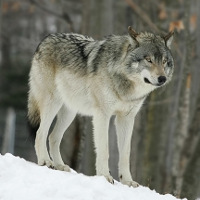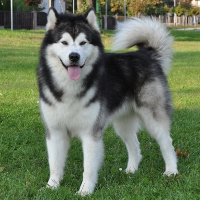Appearance of the Wolamute
|
| It can be extremely difficult to distinguish Wolfhounds from real wolves, as they are similar in appearance and genetics. The only way to tell is by phenotyping, a method that involves observing the animal's physical traits. The Wolf's pointed ears and light and dark grey markings are almost always passed on to Wolfdogs. An adult wolf weighs between 23 and 81.5 kilos and measures between 61 and 91 centimetres. In the wild, a Wolf lives only 6 to 8 years. It's a case of eat or be eaten. Not to mention the fact that wolves are susceptible to over 100 diseases and parasites, including roundworm, tapeworm and cataracts like the Alaskan Malamute. |
Temperament of the Wolamute
|
| It's difficult to pinpoint the Wolamute's behavioral traits. In fact, each wolfhound's temperament varies according to how much of each parent's characteristics it inherits. In addition, the environment in which the dog is raised contributes to shaping its behavior. If you want a well-balanced pet, make sure you socialize it from an early age. Due to its killer instinct inherited from its wolf ancestry, the Wolamute has a very strong propensity for hunting. It will chase small domestic animals and may run over small children. However, this dog can be quite friendly and affectionate towards its masters. But it will not show the same affection to a stranger. Although wary of strangers, the Wolamute can be very friendly and affectionate towards family members. And since they shouldn't be left alone for too long, having a large family can help. However, the dog will only thrive in an active family. In general, wolfhounds need plenty of physical and mental exercise to stay healthy and happy. If you don't offer him enough stimulation, he'll get angry by digging, chewing and adopting similar destructive behaviors. |
Needs and activities of the Wolamute
|
| A Wolamute needs plenty of exercise and high-energy activities to stimulate his body and mind. Otherwise, he'll redirect that energy elsewhere by engaging in destructive behavior. For example, he may climb fences, dig dens and chew up your home's valuables. This dog prefers vigorous exercise. Therefore, he prefers to pull and push heavy objects rather than run aimlessly around the dog park. A Wolamute also enjoys hiking and could benefit from participation in agility classes. The type of exercise a Wolamute requires requires a lot of space. So it may not work out between the two of you if you live in an apartment building. Ideally, your home should have a large fenced-in yard all around to prevent the dog from wandering off. This wolfhound is one of the most intelligent breeds of dog, and responds well to training. However, the territorial instincts and aggression characteristic of its wolf ancestry can sometimes get in the way. You need to be firm and consistent to tame this undesirable behavior. It can also help to socialize the dog from an early age. A Wolamute sees himself as a pack leader, especially if he's not trained from an early age. If you want him to follow your commands, you have to take charge. You need strong, consistent leadership. But don't resort to harsh reprimands; they'll respond better to treats and rewards. |
Maintenance of the Wolamute
|
| The canine's thick, weather-resistant coat requires only moderate grooming. Brushing once a week is enough to maintain its natural shine. However, you may need to brush more often during shedding seasons. Regular bathing is not necessary. Excessive bathing robs the body of its natural oils. But don't forget to brush his teeth regularly and clean his ears to remove any wax build-up. In addition, the sound of their nails on the hard floor should remind you to trim their long claws. Wolfdogs have a reputation for being healthy and robust. Nevertheless, wolfhounds are just as susceptible to health problems as other breeds. Common health problems include arthritis, bone cancer, elbow dysplasia and hip dysplasia. Buying from a reputable breeder is the surest way to ensure you get a healthy puppy that will live as long as nature allows. In fact, the breeder will examine the puppy for any underlying health problems and vaccinate him against rabies and similar canine diseases. |









 English (United Kingdom)
English (United Kingdom)